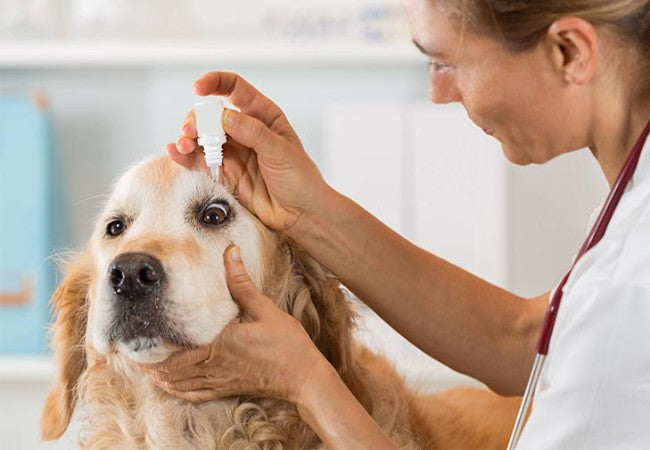Vet’s 2025 Guide to Glaucoma in Dogs – Recognize, Treat & Prevent Vision Loss 🐶

In this article
Vet’s 2025 Guide to Glaucoma in Dogs – Recognize, Treat & Prevent Vision Loss 🐶
By Dr. Duncan Houston BVSc
💡 What Is Glaucoma?
Glaucoma in dogs is caused by improper drainage of ocular fluid, leading to increased intraocular pressure (IOP). This pressure damages the retina and optic nerve, causing intense pain and potentially irreversible blindness if untreated.
👁️ Types of Glaucoma
- Primary: Genetic abnormalities affecting drainage; commonly seen in breeds like Boston Terriers, Cocker Spaniels, Basset Hounds, Beagles, and Huskies.
- Secondary: Caused by eye trauma, inflammation, lens issues, infections, or tumors.
⚠️ Clinical Signs—What to Watch For
- Eye discomfort or pressure—the dog may squint, paw at the eye, or rub the head
- Red, bloodshot whites (conjunctival hyperemia)
- Cloudy or bluish cornea
- Enlarged, bulging eye or pupil
- Vision issues—bumping into objects, dilated pupil
- Systemic signs—lethargy, decreased appetite, or distress
🔬 Diagnosis—Examining the Eye
- Ophthalmic exam: reflexes, pupil shape, corneal clarity
- Tonometry: Measurement of IOP; >25 mmHg is abnormal—acute cases may exceed 40–50 mmHg
- Gonioscopy: Evaluate drainage angle, especially in primary glaucoma
- Ocular ultrasound or ophthalmoscopy: Assess drainage structures, check retina/optic nerve damage
🚑 Treatment Options
🏥 Emergency Management
- Rapid IOP reduction: Hyperosmotic agents like mannitol or oral glycerin
- Topical drugs: Prostaglandin analogs (latanoprost, bimatoprost, travoprost), carbonic anhydrase inhibitors (dorzolamide, brinzolamide), beta blockers (timolol), parasympathomimetics (pilocarpine)
- Pain relief & anti-inflammatories; treat secondary causes—uveitis or lens luxation
🔄 Long-Term Management & Surgery
Glaucoma is chronic and progressive; lifelong management is needed.
- Medical therapy: Regular eye drops (prostaglandins, carbonic anhydrase inhibitors, beta blockers)
- Laser or cyclodestructive surgery: Reduce fluid production in refractory cases
- Shunt implants: Molteno, Baerveldt, Ahmed valves, TR-ClarifEYE for drainage
- Enucleation or evisceration with implant: Considered when the eye is irreversibly blind and painful
📉 Prognosis
- 40% of untreated cases result in blindness within a year
- Early detection + treatment improves comfort and preserves vision in many cases
- Referral to a veterinary ophthalmologist is essential for the best outcomes
🛡️ Prevention & Monitoring
- Routine eye pressure checks for at-risk breeds (Cocker Spaniels, Bassets, Huskies, Beagles, Boston Terriers, etc.)
- Manage underlying eye diseases promptly (uveitis, cataracts, lens luxation)
- Regular veterinary eye exams, especially in middle-aged or predisposed dogs
📲 Tools for Owners & Support
- Ask A Vet: 24/7 telehealth for urgent eye concerns and treatment guidance
🌟 Real-Life Case Study
Case: Daisy, a 7-year-old Cocker Spaniel, presented with a red, cloudy eye and persistent squinting. Tonometry revealed IOP >45 mmHg. Emergency mannitol and latanoprost were administered, then referred to a specialist for valve implant. Daisy retained partial vision and returned to routine integration with lifelong eye drops!
✅ Final Takeaways
- Glaucoma = painful IOP increase → urgent treatment preserves vision
- Breeds with genetic predisposition need regular eye screenings
- Medications may control the disease; advanced cases need surgery
- Prompt specialist referral ensures the best outcomes
- Ask A Vet is your ally for fast response and long-term care 🐾👁️
📥 Immediate Support
If your dog shows signs of eye pain, cloudiness, or vision loss, download the Ask A Vet app now for real‑time vet consultation. Visit AskAVet.com for 24/7 support and guidance. 🐶🩺






